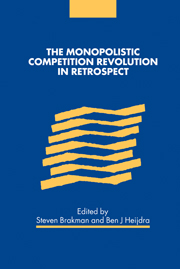Book contents
- Frontmatter
- Contents
- List of contributors
- Preface
- 1 Introduction
- Part I Underground classics
- Part II Current Perspectives
- Part III International trade
- Part IV Economic geography
- Part V Economic growth
- Part VI Macroeconomics
- 17 Monopolistic competition and macroeconomics: theory and quantitative implications
- 18 Does competition make firms enterprising or defensive?
- 19 Rationalisation and specialisation in start-up investment
- 20 Industrial policy in a small open economy
- Index
17 - Monopolistic competition and macroeconomics: theory and quantitative implications
Published online by Cambridge University Press: 22 September 2009
- Frontmatter
- Contents
- List of contributors
- Preface
- 1 Introduction
- Part I Underground classics
- Part II Current Perspectives
- Part III International trade
- Part IV Economic geography
- Part V Economic growth
- Part VI Macroeconomics
- 17 Monopolistic competition and macroeconomics: theory and quantitative implications
- 18 Does competition make firms enterprising or defensive?
- 19 Rationalisation and specialisation in start-up investment
- 20 Industrial policy in a small open economy
- Index
Summary
Motivation
Models with imperfect competition have become central to macroeconomic studies of fluctuations and policy experiments. Many of these papers follow the basic framework of Dixit–Stiglitz (1977) by considering an economy with a large number of differentiated products each produced by a single firm. The success of this framework derives from its:
simple structure that allows for rich microeconomics (product differentiation) but generates aggregate implications
source of inefficiency in the aggregate economy and thus a basis for policy intervention
friction and thus the potential for richer quantitative responses to shocks
link to price setting and thus money non-neutrality.
The goal of this chapter is to discuss these various elements. The work falls naturally into three parts. We begin with the presentation of a basic theory model of monopolistic competition drawing upon the presentation in Blanchard and Kiyotaki (1987). Section 17.3 constructs a dynamic, stochastic version of this model to study business cycle properties. Section 17.4 focuses on policy implications and section 17.5 concludes.
A theory structure
Blanchard and Kiyotaki (1987) provides a convenient structure for understanding the various ways in which monopolistic competition models are used in macroeconomics. The addition of imperfect competition of this form facilitates an analysis of price-setting behaviour along with an understanding of a basic source of inefficiency through market power.
The Blanchard–Kiyotaki framework introduces monopolistic competition in both the production process and in household preferences.
- Type
- Chapter
- Information
- The Monopolistic Competition Revolution in Retrospect , pp. 375 - 398Publisher: Cambridge University PressPrint publication year: 2001
- 4
- Cited by



